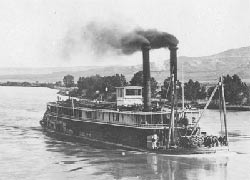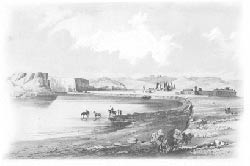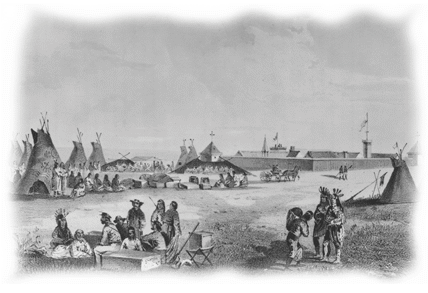- Reclamation
- Missouri Basin and Arkansas-Rio Grande-Texas Gulf
- Multimedia
- Lewis and Clark: Early Commerce
Lewis and Clark: Early Commerce

The Rosebud Steamer on the Missouri River, circa 1850. - State Historical Society of North Dakota 0022H63
As Lewis and Clark traveled down the southern stretch of the Missouri River on their way back to St. Louis in September 1806, they met trappers and fur merchants traveling upstream. By now they knew firsthand that the fur trapping and trading business was well established on the upper Missouri, but it was to expand significantly throughout the next century.
On the day of his arrival in St. Louis, Lewis wrote a letter to President Jefferson, sharing his observations about this historic expedition. In it, he addressed the promise of commerce in theLouisiana Purchase, especially the fur trade:
"We view this passage across the continent as affording immence advantages to the fur trade... The Missouri and all it's branches from the Cheyenne upwards abound more in beaver and common otter, than any other streams on earth, particularly the proportion of them lying within the Rocky Mountains... If the government will only aid, even in a very limited manner, the enterprize of her citizens I am fully convinced that we shall shortly derive the benefits of a most lucrative trade from this source."
While the fur trade on the North American continent began as early as the 1670s, it wasn't until the 1820s that American companies were able to challenge British dominance of the trans-Mississippi fur trade.
Many settlements along the Missouri were involved in exploration and trading in the early 19th century. The river's first fur trade post was Fort Manuel, built by trader Manuel Lisa in September 1809 above the mouth of the Knife River. It was occupied until 1813.
Montana's first fur post on the Missouri was most likely the first house named Fort Union, near the mouth of the Musselshell River, probably sometime in 1829. The Big Bend area in present-day South Dakota was another center of fur trade. And another Fort Union, this one at the confluence of the Missouri and Yellowstone, became, as Lewis and Clark predicted, a dominant trading post on the Upper Missouri. Fort Peck in present-day Montana was another.
The Laramie River in Wyoming was home to Fort William, a center of Rocky Mountain fur trade in the 1830s. It was to become Fort Laramie, and through its gates tens of thousands of pioneers on the trails to Oregon and California passed.
By the 1840s, the population of beaver in western streams was nearly gone, bringing an end to the era. Many of the fur trade posts became military posts, and the trails established by fur traders and mountain men brought permanent settlers to the region.

Fort Benton in Montana. State Historical Society of North Dakota 0239-179
The first steamboat to beat its way upstream from St. Louis in 1819 was the Independence. Steamboat traffic was invaluable for transporting goods and people to the various destination points along the river. In a 40-year period during the explosive western American exploration of the 19th century, the river served as the principal highway for the northwestern fur trade.
In later years, after the discovery of gold in Idaho and Montana, the Missouri proved to be a reasonably safe and speedy route to the mines. By 1860, about 300 steamboats breasted its current annually, some with more success than others. An official report revealed that 297 steamboats were wrecked on its unpredictable waters between 1832 and 1910. Corresponding property losses totaled approximately $50 million. Despite this heavy toll, it was considered to be the safest travel method of getting to the west.
The steamboats also brought disease and tragedy. On June 19, 1837, the St. Peter's arrived at Fort Clark Trading Post just across the Missouri from Lewis and Clark's Fort Mandan and near present-day Stanton, North Dakota. Among the passengers on board were some infected with smallpox. The disease soon spread through the nearby Mandan Indian village, killing some 90 percent of the inhabitants. The epidemic reduced the number of Mandans to less than 150.
The river's importance as a commercial route was significantly diminished in 1887, when the construction of a series of east-west railroads culminated in the completion of the Great Northern Railway into Dakota Territory.

Artist's sketch of Fort Union (State Historical Society of North Dakota C0633)

